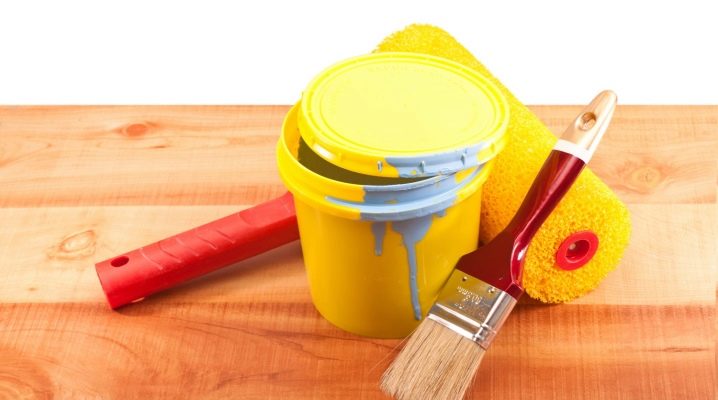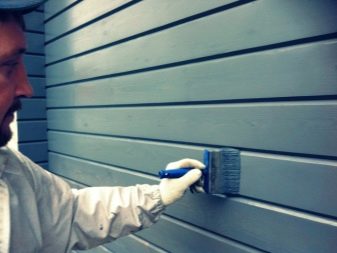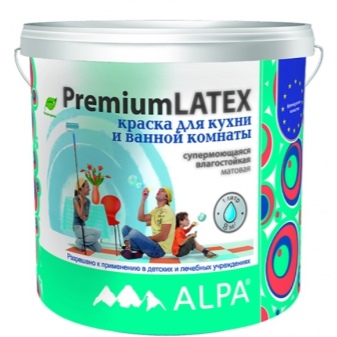Water-based wood paints: types and characteristics

When performing finishing work on wooden surfaces, water-based paint is the best option for paints and varnishes. Several types of water-soluble dyes are intended for external and internal repair work. Their difference from nitro paints, alkyd and oil coloring compositions is that these water-based paints do not contain toxic volatile compounds that are dangerous to human health. In addition to the fact that water-based enamels are odorless paints, they, unlike the above analogs, do not contain flammable compounds and therefore are fireproof dyes.


Varieties and features of coloring compositions
The binder, along with the coloring pigment in such paints, dissolves in ordinary water, therefore all these dyes belong to the group of water-dispersible ones, while the rest of the types are based on chemical solvents. Wood paint is called water-based paint if the binder is liquid in it.
In the production of water-dispersion paints, latexes are used. They can be both polymer artificial resins and natural rubber. The formation of a resistant film on the painted wooden surface occurs due to the adhesion of latex molecules to each other during the evaporation of water when the painted coating dries.


The division into types of water-dispersion paints and varnishes depends on the nature of the binder in the composition of the paint.
The difference lies in the performance characteristics of these dyes. Some of them, due to their low moisture resistance, can be used exclusively for internal woodwork, while others are also suitable for external, outside the walls of the room, decoration.


Acrylic
Acrylic coloring compositions are distinguished by an optimal ratio of price and quality. They are composed of pigments, polyacrylates and fillers. The latter serve to create a smooth painted surface and protect the wood from mold and other microorganisms. The composition of acrylic paints also includes defoamers, flame retardants and other auxiliary additives.
The advantage of this type of dyes is their versatility and low cost compared to other water-dispersible paints and varnishes. Acrylic paints on wood dries very quickly (so several coats can be applied per day) and are durable.


After drying, acrylic forms a dense layer that is resistant to ultraviolet radiation, moisture, temperature extremes and mechanical stress.
Such paint can be black or white in color, in addition, it is possible to add any other colors to it. The acrylic coating lays on the surface in a thin layer and allows you to maintain the texture of the wood. However, along with the manifestation of texture, all defects of the wooden surface are also revealed, which is an undoubted disadvantage of such a dye.
When choosing an acrylic dye, which, for the above reasons, is suitable for both external and internal repair and finishing work, it should be borne in mind that after drying, its shade changes. Therefore, in order to avoid mistakes, you should paint a small surface with it and see how it will look after the paint has dried.


Latex
Polyacrylates are a type of synthetic latex, but in this case, latex paint refers to a material based on styrene-butadiene. Such water-based formulations are cheaper than acrylics, but they also create a less durable coating.
Styrene-butadiene is moisture resistant, wear resistant and elastic. It can work on uneven surfaces, painted wood walls or ceilings. It can be washed, and the service life of such a coating is quite long.


However, latex paint cracks from temperature extremes and turns yellow from ultraviolet radiation, so it can be used exclusively indoors.
Dyes based on pure latex are not so common. Usually, in order to reduce the cost of a product and maintain its quality characteristics, different types of artificial rubber are mixed in one composition. An example is acrylic latex paint. In its composition, styrene-butadiene is combined with acrylates, so it can also be used for outdoor work.


Silicone
These are compositions based on organopolysiloxanes or silicones. Polymers of this class are the most resistant to moisture. They are able to create a layer of hydrophobic self-cleaning film on the wood surface they paint. Therefore, such dyes are used for facades.
These dyes are flexible and effectively protect wood from mold and other microorganisms, they are vapor-permeable and antistatic. The surface covered with silicone paint is resistant to temperature changes and does not deform at extreme temperatures. The service life of silicone paints reaches 25 years, during which these paints, which are distinguished by their versatility, retain their original brightness and color saturation. Like acrylic, silicone paints are sold in white, but they can also be painted using any RAL color scheme.


Silicone in its pure form is a very expensive material; therefore, conventional acrylic dyes with a small amount of polyorganosiloxanes added to them are in mass production. This allows you to significantly improve the performance of standard water-based paint with a slight increase in its cost.
Polyvinyl acetate
This type of water-based paint is one of the best materials for interior woodworking. The properties of polyvinyl acetate coloring compositions depend on the plasticizers added to them, and their general characteristics are fire safety and resistance to chemical attack, elasticity and wear resistance. These paints are resistant to UV radiation and form good adhesion to wood surfaces.
Differing from other latex materials in their brightest color, they have a relatively low price.


However, the list of disadvantages of this type of dyes is also very wide:
- The main one is low moisture resistance. If other water-dispersion dye compositions can be dissolved in water only until they dry, then polyvinyl acetate dyes can be easily washed off with water even after several years of staining the surface with them.
- They are also afraid of low temperatures, so this type of dye is completely unsuitable for outdoor use.


In addition to the above materials, the production of water-dispersion dye compositions can be based on isoprene, urethane and other synthetic types of rubber and various combinations of these polymers. This circumstance affects the properties of paintwork materials insignificantly. All of them have proven themselves perfectly when working on wood: they protect it from decay, easily give it the desired color and do not poison the air with harmful fumes. For this reason, these dyes are ideal finishing materials.
As a paint feed, there is another water-soluble paint material for wood surfaces - wood stain. It cannot protect the wood from damage, but it gives it a beautiful shade while maintaining its texture. Therefore, the stain is one of the finishing materials. The surface painted with stain is additionally opened with varnish.


For the features of a water-based paint that contains wax, see below.













The comment was sent successfully.